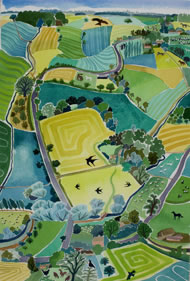I am walking with a friend in a particularly stunning corner of the Cotswolds countryside. The densely wooded, steep-sided valley gives the impression of a wild gorge. A small herd of black cattle roam in the meadows, and gigantic black pigs eye us from behind a wooden fence. My friend’s self-built house is surrounded by well-tended fruit and vegetable plots.
If there could be a realisation of environmentally sustainable farming, then this is surely it, and on this warm morning in early Spring – listening to the birdsong and intoxicated by the smell of hawthorn blossom – it’s hard not to consider throwing in the office job. There is just one problem, as my friend reminds me: there’s absolutely no money in this.
My friend’s problem isn’t unique. It’s extremely difficult to make a living out of farming these days unless you operate at a huge scale. Strip out the grants and subsidies, and it would be near impossible, at least in much of the UK. Take a look at the accounts for most estates, and the income from productive farming is typically a declining element. And only if you are able to sell a few acres to a developer do you have any chance of making money.
This is not to say that land has lost its financial value. Where I was working, near Oxford, you can pay as much as £10,000 for an acre. But this is out of all proportion to the income you might receive from farming, because even with subsidies you would be doing well to generate more than £150 annual income per acre.
Why at a time when we constantly hear about rising food prices and world shortages is there so little money to be had in growing food? It’s tempting to say, “Welcome to the global economy.” Land may be at a premium in the UK, but as long as there are vast tracts of virgin land to be cleared and relatively cheap fossil fuel to be had, we can supercharge food production by pumping in scarce resources and eating into our environmental capital. And in this global game, it is the big players who hold sway. Just as dense patches of nettle dominate on the highly fertile ash of a bonfire site, so in our supercharged food economy we can expect the growth of super-sized farms. Which means relatively small farms stand about as much chance of survival as a rare orchid on a compost heap.
But the problem goes much deeper than economics. Perhaps more than anything else, the way we manage land is a physical embodiment of our relationship with the environment. We have become increasingly disconnected from the land and the impacts our day-to-day decisions have on it. This is partly because of our urban lifestyle, but it equally reflects the bewildering complexity of the food system.
Just mapping the journey of a product from farm to shop can be a major undertaking. It is almost impossible to avoid buying goods with ingredients linked to damaging land somewhere. Palm oil, which finds its way into 10% of the contents of our shopping baskets, is a case in point. As consumers our relationship is with the shop, and the journey of most products from the land to the supermarket shelf is convoluted to the point where it becomes too baffling or just too remote to contemplate.
There seems to be a crisis in our conception of what land and farming are there to do. Politicians in Europe have long extolled the virtues of a strong agricultural sector, and the need to protect the best farmland. Recently, the mantra has become one of better businesses, less reliance on subsidies, and reduced regulation – as boldly stated in a recent speech by Secretary of State Caroline Spelman to the farming community.
There’s nothing wrong with being business-like; most ecosystems in balance reach a level of resource efficiency we can only dream of. It’s just that as a policy framework this isn’t nearly enough. It conflates how you operate with why you operate. It assumes that market forces will eventually steer us towards more ecologically and socially efficient forms of land use. But the market might not deem it ‘efficient’ to tackle chronic food insecurity. And markets are seldom effective at pre-empting trouble ahead. For some time yet it will almost certainly remain easier to dig up vast tracts of Canada and Venezuela for tar sands, or clear yet more rainforest, than find more sustainable ways of managing the land already in production.
A recent UK Government Office for Science Foresight report sets out a stark list of challenges for food and farming over the next 50 years. To its credit, the report pulls few punches, and stresses the food system’s intricate links with climate change, biodiversity loss and global poverty. But we need to ask why these issues, many of which were described by E.F. Schumacher and others more than 40 years ago, remain with us.
In the first place, this is a problem of scale. We stand little chance of influencing the food economy globally if we do not understand it at a local level. The LandShare project How to Feed a City looks at the land, energy and water needed to sustain the diets of an urban population of 150,000 (the size of Oxford’s). It’s a sobering insight into just how big the gap is between our demand on resources and their availability, and how little of our food (less than 0.5%) is supplied locally. But it’s also empowering, because it brings the problem down to a level that most of us can visualise. This makes it easier to pinpoint possible solutions, such as creating integrated networks of small-scale producers.
Secondly, we need to recognise the true value of land. We seem to have forgotten why we farm land, and that land itself is an entity with a crucial relationship to us. We need to have the courage to look at farming as more than a simple utility and to spell out a vision that puts the long-term sustainability of the land back in the centre. It needs to be driven by the principles of long-term care, stewardship and relationship, rather than just short-term market efficiency. It needs to leave a place for the small, mixed farm in the Cotswolds.
Finally, we need to create a vision for land that has meaning. Many wildlife and conservation organisations have succeeded in capturing people’s imagination solely because their campaigns are embedded in emotionally charged, visually based images of the land – albeit often rooted nostalgically in the past. If we too want to change hearts and minds, terms like ‘low carbon’ and ‘sustainable resource management’ just don’t cut it, because they give us no clue about what a future landscape might look like. Instead, we need to paint a picture of how we would like farming to appear in the future, and use it to build support for an alternative vision.
Andy Warhol once said, “Having land and not ruining it is the most beautiful art that anybody could ever want to own.” This isn’t just a puzzle for economists and policymakers. We have ignored the philosophical dimension of land and farming. We need to put the visual and the emotional, as well as the functional, back into the heart of decision-making that will reverse this.
The Devon Wildlife Trust campaigns to protect the natural environment across Devon and in the surrounding seas. www.devonwildlifetrust.org.uk








